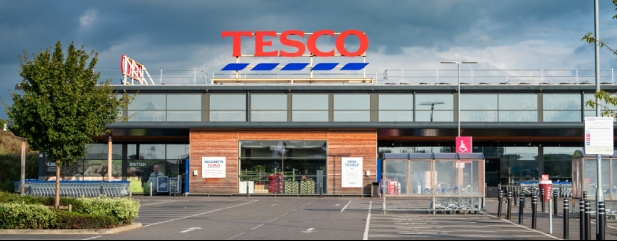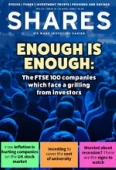Archived article
Please note that tax, investment, pension and ISA rules can change and the information and any views contained in this article may now be inaccurate.
How inflation is hurting companies on the UK stock market

UK inflation is officially running at 7%, but unfortunately it is likely to go higher once the impact of the Ukraine conflict and the removal of the energy price cap take effect.
A year ago, consumer prices weren’t even a concern, now they are front and centre with Google Trends showing internet searches for inflation hitting the highest level in nearly two decades.
FOOD SHOPPING HABITS ALREADY CHANGING
Retail is one of the sectors feeling the pinch as the cost of living crisis cuts into shoppers’ willingness to spend.
Supermarket Tesco (TSCO) has invested heavily to keep prices down in its stores through its Aldi Price Match campaign and its Clubcard offers. While that has worked in terms of market share, with the grocer still taking more than a quarter of all UK spending on groceries according to research group Kantar, its margins have suffered as a result.
In its latest update, the firm revealed operating profits for the year to February were below the bottom of the range of market expectations.
Just as disappointing, the forecast for the year to next February was also below the bottom end of the range.
Not only are shoppers visiting stores less, they are putting fewer items in their baskets each time with the result that sales by volume are down over 10% in the first three months of the year.
According to a survey commissioned by Tesco, the number one response by consumers to the squeeze on their incomes is to trade down to cheaper items. This is backed up by further research from Kantar which shows half of all goods bought at supermarkets in the first quarter were own-label products.
CLOTHING RETAILERS WORRIED
Elevated inflation is also reflected in cautious outlook statements from clothing retailers. Margins are being impacted by higher wage and freight costs, while the growing pressures on consumer spending look set to dampen demand for non-essential items.
Online fashion seller ASOS (ASC) says the external environment has become more challenging. It sees greater risk than normal as the full impact of inflationary pressures and the potential impact on the discretionary spend on customers is yet to be felt.
This warning followed cautious commentary from retail bellwether Next (NXT), which left first-half like-for-like selling price expectations unchanged at 3.7% but upped its estimate for second-half selling price inflation from 6% to 8%.
Next explained ‘the inflation we are experiencing is a symptom of underlying constraints in the supply of goods’, though how such price increases impact demand is yet to be seen.
Consumer goods group PZ Cussons (PZC) has successfully increased prices to help counter inflation, but CEO Jonathan Myers says the external environment is among ‘the most challenging many of us have seen’.
The Carex-to-Morning Fresh maker is ‘removing costs that the consumer does not value’ and has ‘plans in place to meet evolving consumer needs, including innovation to offer everyday great value as well as more premium-priced launches’.
DEMAND COULD FALL FOR BIG TICKET ITEMS
Rampant inflation is likely to have a big impact on demand for big ticket items such as furniture and cars. Automotive retailer Lookers (LOOK) said on 6 April that first quarter trading had been strong despite new vehicle supply remaining tight. However, it is mindful that Covid is still disrupting life, the Ukraine war is ongoing, and significant cost of living increases are putting pressure on disposable incomes.
Furniture retailers are having to contending with higher raw material and shipping costs. Sofa sellers DFS Furniture (DFS) and ScS (SCS) last updated the market in March, so we’ve yet to learn if soaring inflation hurt sales over the Easter bank holiday, though both businesses have exhibited resilience so far.
AIRLINES REMAIN SURPRISINGLY OPTIMISTIC
Soaring fuel costs threaten to clip the wings of the airline sector’s recovery just as demand starts to return from two years of Covid disruption.
Crude oil prices have surged from $65 to $111 a barrel since August 2021, while jet fuel has soared 125% to $159.20 a barrel during the past 12 months, according to data from Platts. With fuel making up to a third of many airlines’ running costs will passengers pay higher prices for seats or will planes be half empty this summer?
Recent updates from the sector seem to have been dominated by a lack of staff forcing hundreds of flights to be cancelled around Easter, hitting EasyJet (EZJ) and British Airways-owner International Consolidated Airlines (IAFG) hardest yet the companies remain optimistic.
Alongside first-half results on 12 April, EasyJet talked up a ‘strong, sustained recovery in trading’ since the relaxation of travel restrictions, reflecting the pent-up demand coming out of the pandemic, with capacity through March up to 80% of 2019 pre-pandemic levels.
Two days later Wizz Air (WIZZ) shrugged off Covid and war in Ukraine to upgrade its forecasts. It is preparing to ramp up operations and crew numbers in preparation for ‘a busy summer’, news of which sent its share price up 8%.
Important information:
These articles are provided by Shares magazine which is published by AJ Bell Media, a part of AJ Bell. Shares is not written by AJ Bell.
Shares is provided for your general information and use and is not a personal recommendation to invest. It is not intended to be relied upon by you in making or not making any investment decisions. The investments referred to in these articles will not be suitable for all investors. If in doubt please seek appropriate independent financial advice.
Investors acting on the information in these articles do so at their own risk and AJ Bell Media and its staff do not accept liability for losses suffered by investors as a result of their investment decisions.
Issue contents
Feature
- Enough is enough: The FTSE 100 companies which face a grilling from investors
- Specialist distributor Diploma is a rare winner from global supply chain constraints
- How investors including people in retirement should deal with 7% inflation
- A complete exit from Russia is likely to cost companies dearly

 magazine
magazine









